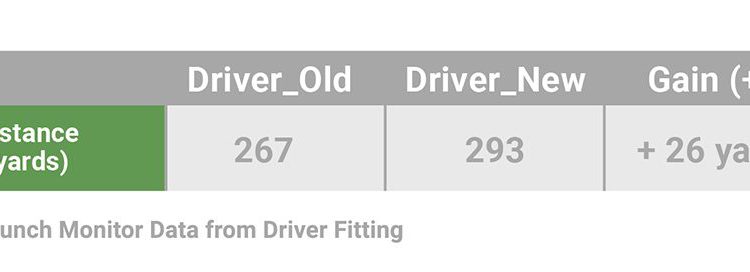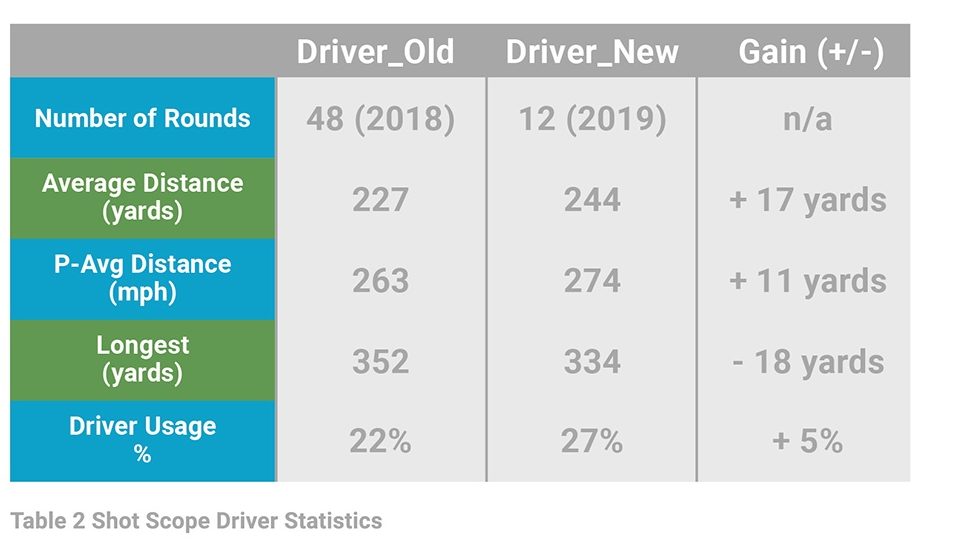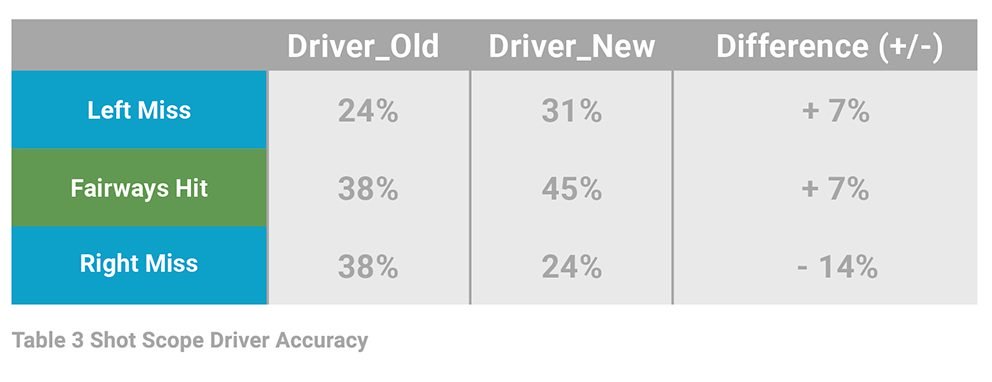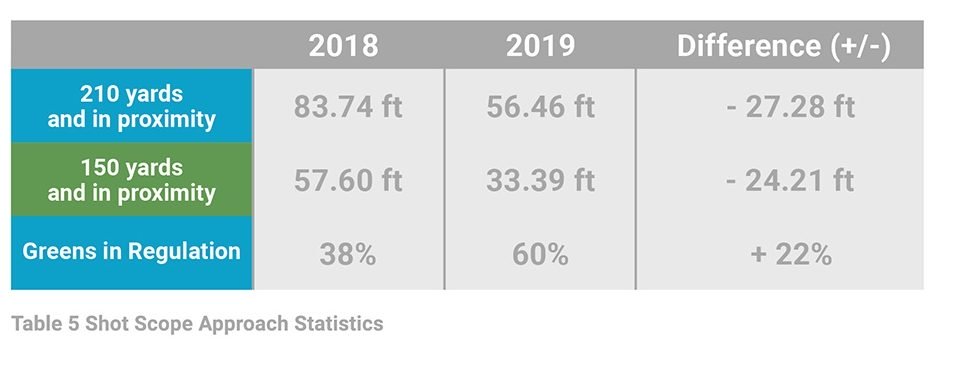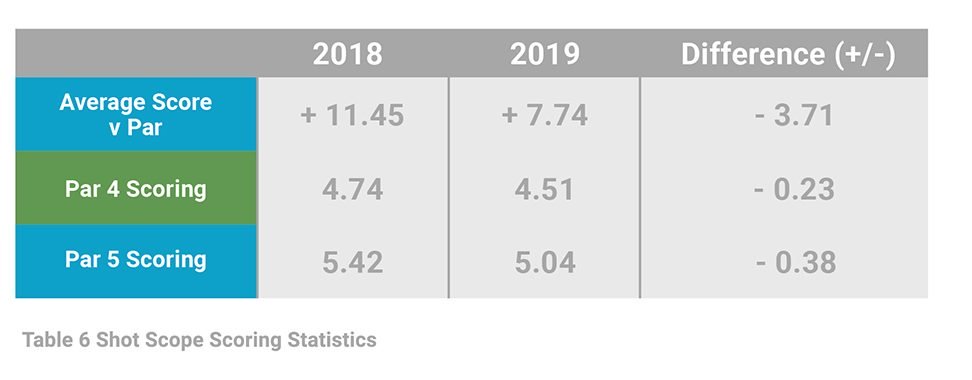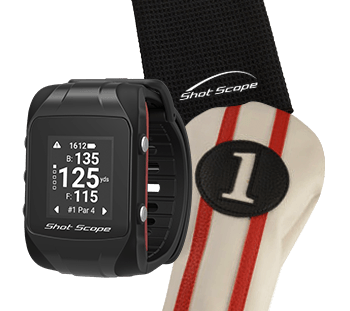The purpose of this study is not to promote a specific club or brand but to discuss and show the merits of custom fitting and how it can make a real performance difference. A Shot Scope user, like many golfers do every season, made the decision to invest in a new driver.
The question posed to Shot Scope: Was the $500 investment worth it?
Firstly, about the driver change. The original driver (Driver_Old) was from a well-known brand and was purchased new in 2009. It had an extra stiff shaft with 9 degrees loft. The new driver (Driver_New) is the latest release from the same brand and has an extra stiff shaft with 10.5 degrees loft.
During the fitting process, multiple drivers and shafts were tested. Driver_New was found to be, on average, 26 yards longer (using a Launch Monitor) than Driver_Old.
Discussing with the golfer, he said that he felt he was playing better with the new driver, and while he had lowered his handicap from 8.8 to 7.2 already this year, he attributed the improvement to other areas of his game.
Looking through his Shot Scope performance data, some things stood out:
It is obvious to see that Driver_New is longer than Driver_Old. Looking at Average Distance it is 17 yards longer. However, if we look at P-Avg (Performance Average), it is only 11 yards longer.
*Shot Scope recommend users typically refer to their P-Avg Distance (Performance Average) as it removes all outliers (good and bad), to give the user a true representation of how far they hit a good shot.
This isn’t the 26 yards he saw during his fitting, but some mitigating factors don’t come through in the performance data. In 2018 summer golf in the UK was played in unusually hard and fast conditions creating some uncharacteristically long drives, including his longest at 352 yards.
The primary takeaway from the distance statistics is his consistency. Driver_Old had a 36-yard difference between the average and the performance average, whereas Driver_New has reduced that difference to 30 yards. Not only is Driver_New longer, but it also has better distance consistency as well.
This, unsurprisingly, has created increased confidence with Driver_New, resulting in a higher usage % – 27% compared to Driver_Old’s 22%.
Has this resulted in more fairways hit? Well yes!
We can see from his Shot Scope performance statistics that he has increased his fairways hit percentage to 45%, compared to 38% with his previous driver. As well as hitting more fairways, he has reduced his right miss by 14 percentage points, now down to 24% with Driver_New.
Looking into this further, we discover that his misses are, in fact, smaller misses with Driver_New.
His average miss with Driver_New is only 11.7 yards from the fairway whereas with Driver_Old it was 5 yards more off-line at 16.2 yards.
With a more in-depth understanding performance statistics from Shot Scope, we can conclude that Driver_New is longer, more consistent, and more accurate Driver_Old, but the most import question is, did the new driver lower his scoring?
The next area to look into is approach shots:
He has increased his Greens in Regulation by a massive 22% in 2019. Not only this, but he is hitting the ball considerably closer to the pin compared to last year – over 20ft closer! There is little doubt that this is the result of hitting more fairways and being more accurate off the tee with Driver_New. Because of improved driver performance, he’s leaving himself better approach shot positions, with more approaches from fairways and fewer from significantly offline.
As the golfer mentioned, he has lowered his handicap, and the scoring improvements are reflected in the Shot Scope performance data.
Total round scoring has improved by 3.71 shots, with Par 4 and Par 5 scoring both improving due to his better driving and subsequent approach performance.
A great way to show that the improvement can be attributed to Driver_New is through Par 3 scoring, where is performance has remained mostly static.
It is evident that custom fitting can improve scoring, though it should be noted that this case is particularly dramatic because of the 10-year gap in the technology of the drivers.
Most importantly, one Shot Scope user can sleep soundly knowing his $500 investment was worthwhile and can be even more confident in using his driver to find more fairways.
Understanding Shot Scope statistics can help golfers better identify how they can improve their performance while allowing visibility into year over year changes. Knowing how to analyze and leverage your Shot Scope statistics can be hugely beneficial to your game.
For more information on Shot Scope, visit shotscope.com.

